We did not mean to save the best for last. Even now, my wife and I debate which day in Glacier National Park was our favorite. One thing we don't argue about, however, is that our last day is right up there at the top. The closest possible competition was the day we hiked to Sperry Glacier. We still debate which of those two days were our favorite. Gunsight Lake would have been high on the list if it hadn't of been for the bugs. A good day, for sure, but the bugs guaranteed it wouldn't be our favorite.
On our last day in Glacier National Park, we really wanted to do a big hike that my friend John had told me about. Siyeh Pass is best done as a through hike that utilizes the Park's shuttle system to get from one trailhead to the other. Of course, with COVID going on, this wasn't going to be an option. We briefly considered just making the hike up or down the road. In the end, however, we decided to begin and end at Siyeh Bend. This would strictly be an out and back hike. Our goal was a quick hike up to Siyeh Pass to enjoy the wildflowers in Preston Park.
The whole trip would be about nine miles, just a quick jaunt at this point in our trip. We decided to skip carrying lunch for such a short hike. This was a small mistake but not one that we would notice too badly. That morning, we almost thought we wouldn't be able to do the hike. We woke up to thunder and lightning and a much needed rain shower passing through. The early morning was gloomy, but soon gave way to the dramatic.
Sunrise in Glacier National Park
As the rising sun slanted over the top of the mountains, the rich early light lit up the appropriately named Heavens Peak. We had checked the radar and thought we would be able to hike, but the sky was quite foreboding at this point. Here is a closeup of Heavens Peak along with a wider angle shot showing the dramatic sky.
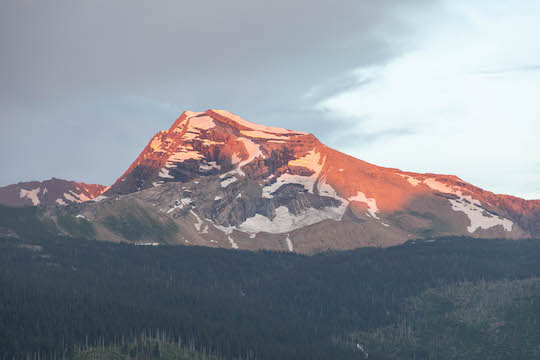 |
| Heavens Peak at Sunrise ©2020 David Knapp Photography |
 |
| Sky On Fire Over Heavens Peak ©2020 David Knapp Photography |
The dramatic light did not last long. The sunlight was slanting under the clouds from the east and lighting up the sky to our west. These shots were taken from Trail Ridge Road looking west. The light was just barely coming over the top of the ridge to our east before the clouds covered the sun. This is looking up towards Logan Pass from the same place.
 |
| Looking Towards Logan Pass at Sunrise ©2020 David Knapp Photography |
The dramatic quickly turned a flat gray. It seemed obvious that we were about to get wet and our hike would either be delayed or ended completely before it began. This is higher up towards the pass looking south.
 |
| Bird Woman Falls ©2020 David Knapp Photography |
Surprise Bonus
Around this time, we came across another special bird that I had last seen just days before near Sperry Glacier. The ptarmigan is a neat bird that I had always wanted to photograph. Somehow, on this trip, I got two opportunities! This one wasn't great in terms of the setting, but I did have another picture of a ptarmigan. This one was in full summer dress with just hints of white left from the winter coat and blended in perfectly with all the rocks and brush nearby.
 |
| Ptarmigan Beside Going to the Sun Road ©2020 David Knapp Photography |
Parking at Siyeh Bend and Preparing for Our Hike
We soon resumed our trip towards the parking area at Siyeh Bend. As with all other mornings, we got there early to snag a parking spot. It was a good thing we got there when we did. Breakfast came out next and we watched as the last few parking spots were taken. If we had been 30 minutes later, there would have been no hiking or at least a much longer hike. As we ate breakfast, the sky turned even more dramatic before starting to look like things would clear up. Mammatus clouds loomed over Going to the Sun Mountain and also off to the south before drifting on to the east.
 |
| Dramatic Clouds Over Siyeh Bend ©2020 David Knapp Photography |
 |
| Mammatus Clouds and Going to the Sun Mountain ©2020 David Knapp Photography |
Looking back towards the west, we finally started to think this hike would happen after all. Neither of us wanted to get caught above tree line in a lightning storm. Thankfully, the area of disturbed weather seemed to be passing us by finally. We got our packs ready, loaded with water and grabbed our cameras. We had already experienced some incredible scenery and dramatic views and we hadn't even hit the trail yet!
Beginning Our Hike to Siyeh Pass
Just across the road, we began hiking up the short bit of trail that parallels Siyeh Creek. The wildflowers that were blooming there were just a foreshadowing of things to come. This hike would easily win for best wildflower hike of our trip. At this point, however, we didn't yet know that and were just glad to be finding some amazing color and scenery.
 |
| Siyeh Creek Looking Towards Piegan Pass ©2020 David Knapp Photography |
It didn't take long before the trail started heading rapidly higher. Coming around one sharp corner, we ran into our only up close big animal for the day. This skinny looking doe was eating as much as she could and clearly needed still more food. We quickly snapped a picture or two and then kept going.
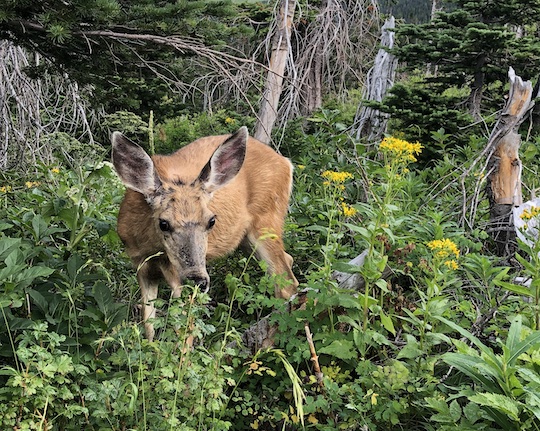 |
| Doe Mule Deer Spotted While Hiking to Siyeh Pass ©2020 David Knapp Photography |
We were in a hurry so to speak. You see, much of this hike is through exposed terrain without any canopy to keep off the hot sun. At this point, we were still fortunate to have widespread clouds to shade us a bit longer and wanted to make the most of this nice cool morning. Climbing rapidly higher, the trees started to thin out as we approached our second trail junction of the day. Our first trail junction happened when we turned onto the Piegan Pass Trail. This second junction was when we finally turned off on the Siyeh Pass Trail and began ascending into Preston Park. The wildflowers were already amazing. Without knowing how stunning things would be yet ahead, we began taking a lot of pictures and our pace slowed dramatically.
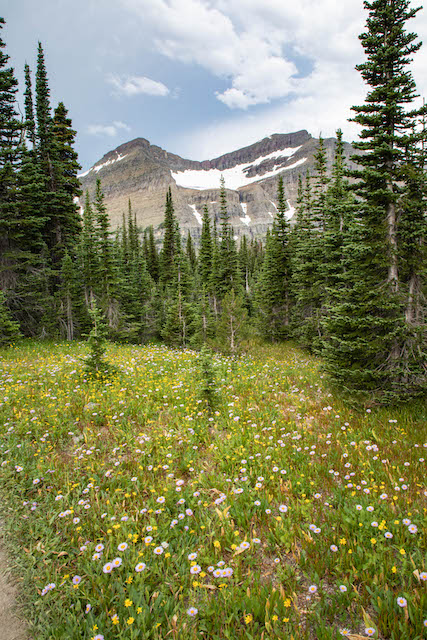 |
| Mt. Siyeh Looming Over Everything ©2020 David Knapp Photography |
 |
| A Hint of Extraodinary Things to Come ©2020 David Knapp Photography |
Wildflowers Of Preston Park
Soon, we found ourselves wandering slowly up through Preston Park. Again and again we found ourselves stopping to take pictures from different angles of the extraordinary scenery we were passing through. I was going from one extreme to the other. I wanted to capture the entire view and also all the details. The sheer number and volume of wildflowers had me really wishing that I had carried my tripod on this hike to get some better pictures. Alas, I have just another good reason to go back someday.
 |
Large Mountain Monkey-Flower ©2020 David Knapp Photography
|
 |
| Alpine Forget-Me-Not ©2020 David Knapp Photography |
After the wildflowers, I looked around and took what would become one of many. The views back down Preston Park to the west and southwest were just incredible. I think I could dedicate a whole day just to take various versions of these pictures. To the right is Piegan Mountain with Heavy Runner Mountain in the distance in the middle. The left side of the first picture is the side of Matahpi Peak. Sometime, I want to go back and climb some of these mountains, but especially Piegan and Siyeh.
 |
| Matahpi Peak Flanks, Piegan Mountain, and Heavy Runner Mountain ©2020 David Knapp Photography |
 |
| Heavy Runner Mountain and Siyeh Creek Headwaters ©2020 David Knapp Photography |
Shortly after taking these pictures, I came across one of my favorite wildflower displays of the whole trip. Yellow Columbine were high on my list of favorites from this trip, and I found them growing in such numbers that it was literally overwhelming. I didn't even know which way to point the camera, but somehow I managed to snap a couple pictures.
 |
| Yellow Columbine Along Siyeh Pass Trail ©2020 David Knapp Photography |
Of course, it wasn't long before I was looking at the bigger picture again. At some point, I had wandered out ahead with my camera while my wife was further back taking some closeups. I cannot remember if she was taking pictures of flowers or ground squirrels, but I'm guessing it was the latter. She was always on the lookout for animals on this trip!
 |
| My Wife Looking for the Next Shot ©2020 David Knapp Photography |
Siyeh Pass
Another large mammal encounter awaited as us we finally made it to Siyeh Pass itself. This female bighorn sheep wandered out across the stark and now barren landscape of the pass. I can't imagine how incredibly harsh this environment is during the winter months. Intense winds and snow scour this landscape every winter. In the warmth of summer, however, the wild critters venture through this otherwise wild landscape to feed on the transitory abundance. The wildflowers take advantage of the brief growing season before going dormant for yet another long cold winter.
 |
| Siyeh Pass Bighorn Sheep ©2020 David Knapp Photography |
As we enjoyed the views from Siyeh Pass, we were reminded that lunch would be nice by the other hikers enjoying their lunches there. Briefly, we contemplated enjoying our raspberry fig bars, but instead decided to make a quick descent back to the car for a full blown lunch. Funny how our plans don't always happen the way we think...
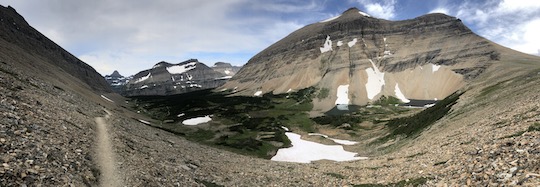 |
| Panorama Just Below Siyeh Pass ©2020 David Knapp Photography |
 |
| Selfie Near Siyeh Pass ©2020 David Knapp Photography |
Descending the Siyeh Pass Trail Through Preston Park
As we began descending, I couldn't just walk away without a few more wildflower shots. Okay, maybe a lot of wildflower shots. Up close, further back, landscape scenic shots still featuring wildflowers, more yellow Columbine, I just couldn't get enough. We were just about to have our day extended, but at the time, I just figured we had a quick descent and a few extra minutes wouldn't hurt.
 |
| Dwarf Fireweed Near Siyeh Pass Trail ©2020 David Knapp Photography |
 |
| Rocky Ledge Penstemon ©2020 David Knapp Photography |
 |
| Piegan Mountain and Wildflowers ©2020 David Knapp |
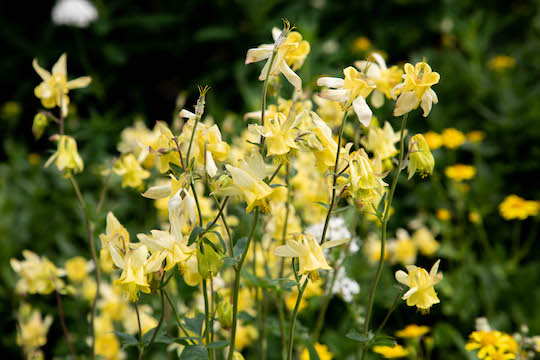 |
| Yellow Columbine ©2020 David Knapp Photography |
 |
| Preston Park Wildflowers ©2020 David Knapp Photography |
Shortly after taking this last picture, I ran into the most interesting gentleman. He was retired and lived in nearby Kalispell, Montana. He was a Vietnam Veteran who spent most of his free time in Glacier National Park, hiking, enjoying photography, and otherwise having great adventures. We struck up a conversation and soon he was telling me more about the surrounding landscape than I could have ever read in a trail guide or other book. He mentioned that he would probably go up on Piegan Mountain for the day, but since the day was still young, he wasn't sure what he might end up doing yet. I asked about Piegan Pass, to which he replied that we really needed to go up there to see it. "It is only a couple of miles up there," he said. Our short nine mile day with just a couple of snacks and two liters of water each was about to morph into yet another thirteen mile hike.
We continued talking for a good long while. I asked about the large mammals that he had seen. Apparently he had seen just about all of them. Then, I asked about wolverines. When planning this trip, I had read that Glacier National Park is the best place in the Lower 48 to see a wolverine. Everything is relative, of course, but I still thought that was pretty intriguing. As it turns out, that is one animal this gentleman had not seen. He had missed seeing one by about fifteen minutes one time, but never had he seen one himself. Just another reason to return to this amazing National Park!!!
After finally wrapping up my discussion with this interesting guy, I talked to my wife and explained what he had told me. She agreed that we should go ahead and head up to Piegan Pass. We both knew we might get pretty hungry, but this was a potential once in a lifetime trip. You just never know when you'll be on an adventure to Glacier National Park again.
Hiking to Piegan Pass
We quickly hiked back down to the trail junction with just a couple of stops for pictures. One interesting flower we spotted was the western anemone. This flower has a beautiful silky fruiting head after the flower blooms. These silky heads were so incredibly soft. You have to see and touch it to grasp just how soft these are!
 |
| Western Anemone ©2020 David Knapp Photography |
By the time we got back down to the junction with the Piegan Pass Trail, the sun was high overhead and beginning to finally break through the clouds. This would be a bright sunny hike along a very exposed section of trail. The hike was absolutely worth it, however! We had to cross a couple of large snowfields that were still drifted over the trail. We carefully took our time. If you start sliding on some of these snowfields, the final landing spot is on rather jagged rocks far below and you don't want to make that mistake. Here are a couple of views of the trail.
 |
| Looking Towards Piegan Pass ©2020 David Knapp Photography |
 |
| Piegan Pass Trail ©2020 David Knapp Photography |
As we ascended closer and closer to the pass, the bulk of Piegan Mountain was well off to our left, providing impressive views. Suddenly, we noticed some specks moving across the large expanse of white on the flanks of the mountain. Upon closer inspection, we realized we were looking at a couple of bighorn sheep. Here is what we saw.
 |
| Mountain Sheep and Snowfields ©2020 David Knapp Photography |
 |
| Can You Find the Bighorn Sheep? ©2020 David Knapp Photography |
At this point, we were nearly at the pass. As we entered the pass, we found amazing views down towards the Many Glacier portion of Glacier National Park. We had hoped to spend a lot of time on this side of the Park. Alas, they had closed it down due to COVID, greatly adding to the crowding and congestion in other portions of the Park. Oh well, next time we'll explore this area. We took some quick pictures, finally ate our snack, and then finished off our water. We now had a good long walk ahead of us before we found water again. It was time to head downhill.
 |
| The North Side of Piegan Pass ©2020 David Knapp Photography |
 |
| Big Views at Piegan Pass ©2020 David Knapp Photography |
 |
| Piegan Pass Selfie ©2020 David Knapp Photography |
The Hike Back Down
The return hike went rather quickly. This trail is a nice gentle grade without too many steep sections. We were able to make incredibly good time. At this point in our trip, we were both in peak hiking condition and could really crank out the miles. The only thing that slowed us down was the wildflowers. I know, big surprise, right?!?!
I found some beargrass blooming and had to make a few more photographs. This is an incredible wildflower and iconic of Glacier National Park. In addition to photographing a few more flowers, we also stopped at the first good stream crossing to filter some fresh drinking water. We were both getting a little parched at this point!
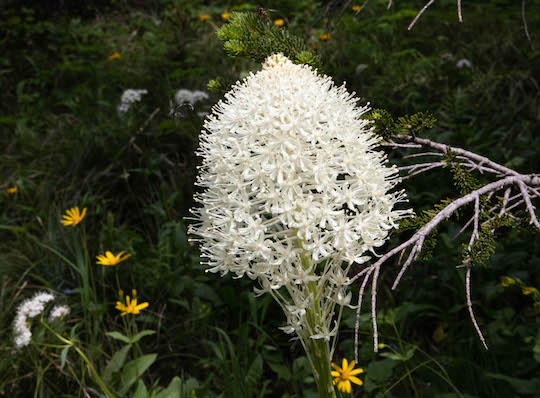 |
| Beargrass ©2020 David Knapp Photography |
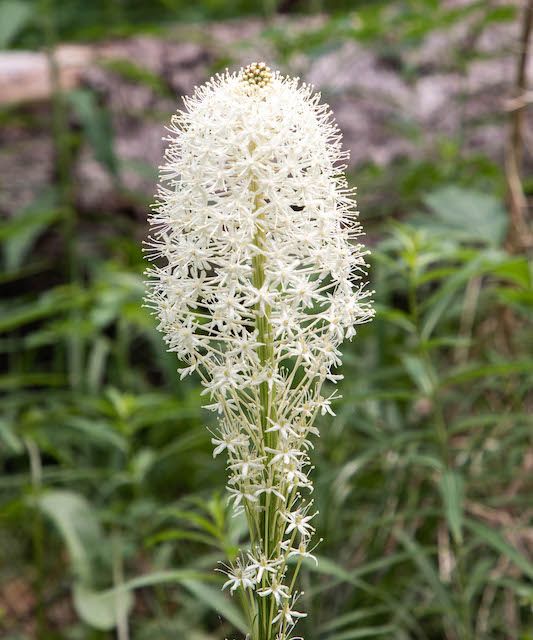 |
| Beargrass Trailside ©2020 David Knapp Photography |
 |
| Beargrass Looking Towards Matahpi Peak ©2020 David Knapp Photography |
We made it back to the car in good shape, just a little more hungry than we had intended. Lunch happened and then we turned our car back towards camp for our final night in Glacier National Park. One adventure was wrapping up, but another was just about to begin. The next phase of our trip would involve a little more fishing and chasing a bucket list fish for me, the bull trout. On our way back to camp, we found the bighorn sheep hanging out at the Logan Pass Visitor Center Parking lot again. We had to take a few more shots of them of course...
 |
| Bighorn Sheep at Logan Pass Visitor Center ©2020 David Knapp Photography |



















































